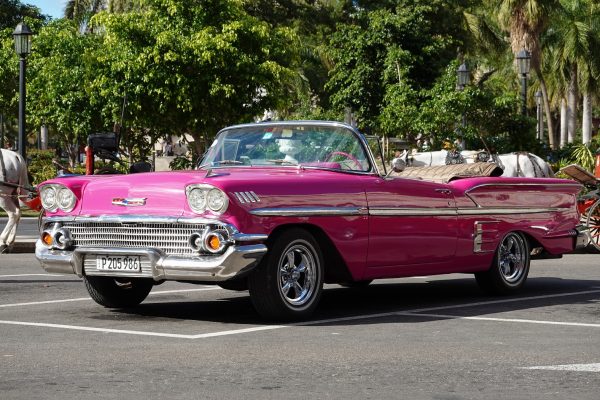How to import a car from the USA to the UK

If youâve fallen for a classic car in the USA it can be heartbreaking to fly home without it, but the return journey neednât be the end of the love story. There are hoops to jump through, but nowadays itâs not too difficult to import a car from the USA to the UK.
In this blog the imported car insurance experts at Adrian Flux outline exactly what you must do to import your dream American car and how to make it legal once it arrives in the UK.
Photo by Tyler Clemmensen on Unsplash.
1. Identify a car shipping specialist
Your first job is to identify a reputable car shipping firm. For a fee, the good ones offer a pick-up service from most locations within the US, though you may choose to get a feel for your new car and save a few pounds by driving it there yourself. If itâs a non-running project car youâll need to organise trailer transport independently or with the shipping agent.
Itâs advisable to get photographs of the car before itâs left with the shipping firm, just in case it sustains damage en route.
Customs clearance can take up to a week and you will need to provide the vehicle registration document, your passport and a bill of sale to get it through the checks to leave the US.
Most cars tend to be sent by sea container as air passage is prohibitively expensive. Some specialists also allow you to ship parts and spares inside your car. This is handy for a âdoer upperâ or a classic for which you might struggle to find spares for in the UK.
The shipping agent will give you three options for shipping:
You can select a âroll on, roll offâ service where the car is driven onto the boat
Shared container shipping, where your car will be packed with other goods for export
Private container shipping, the best but most expensive option, where your car will have exclusive use of a container.
Shipping a car from California to the UK costs around £1,000 and the passage could take up to a month. Shipping from the east coast, from New Jersey, for example, would cost around £700 and take about two weeks. Most American imports are shipped into Southampton or Felixstowe while cars imported from Europe tend to arrive at Dover.
2. Get the paperwork for your imported car in order
Once the car has landed in the UK, it will need to be collected from the port and cleared by customs. There are a number of steps that need to be followed, and most shippers will charge around £500 to help you smoothly negotiate the red tape.
First you must inform HM Revenue and Customs (HMRC) that the vehicle is in the UK. This must be done within 14 days of arrival. You can do this by using the Notification of Vehicle Arrivals (NOVA) online tool. A paper notification option is also available but will take a lot longer.
You will need to pay tax and VAT at a rate of 10% of the total value of the vehicle and 20% VAT on top of that. However, if the car is over 30 years old and will not be used as a daily driver, the duty should be waived and the VAT reduced to five percent.
If you are a private individual or are importing the car through a non-VAT-registered business, you wonât need to fill in the NOVA. You will still need to contact HMRC to find out which forms you do need to fill in.
3. Register your imported car
Once the payment has been made, HMRC will provide online confirmation that the vehicle can be registered with the DVLA. For this process, you will be required to complete and produce the following:
A V55/5 application form.
Pay the vehicle tax as specified by HMRC.
Supply an original non-UK registration document.
Provide a certificate of insurance using the Vehicle Identification Number (VIN).
A fresh MOT certificate.
Your name and address using a driving licence or passport for authentication, and a utility bill for the address.
If youâre importing the car through a business you will be required to provide proof of your business address.
Evidence of Type Approval. This can be in the form of a Certificate of Conformity, Mutual Recognition Certificate or evidence of previous UK registration (V5C form). If none of these forms is available, an Individual Vehicle Approval (IVA) test will need to be carried out.
The first registration fee of £55.
You can be prosecuted if you use your vehicle on a public road before completing these steps, unless youâre driving it to a pre-booked MOT or vehicle approval test. Visit the government website to find out more about importing a vehicle.
Read our blog to find out more about driving endorsement codes and penalty points.

Photo by Jeremy Bezanger on Unsplash.
4. Get your car home
Before you drive the car in the UK you may need to make certain alterations, such as fitting amber indicator lenses, to make it fit for the road.
You will also need to get the vehicle taxed, insured, MOTâd and fitted with UK number plates before you can drive it home.
Adrian Flux specialises in niche motoring markets and provides low cost, high quality insurance for all imported vehicles â including American imports â whether they are grey imports, left hand drive models, customised vehicles or classic cars.
For a swift insurance quote for your newly imported vehicle, call 0333 256 8940 or book a callback at a time that suits you.
Read our blog on the special requirements for classic car insurance to find out more.







